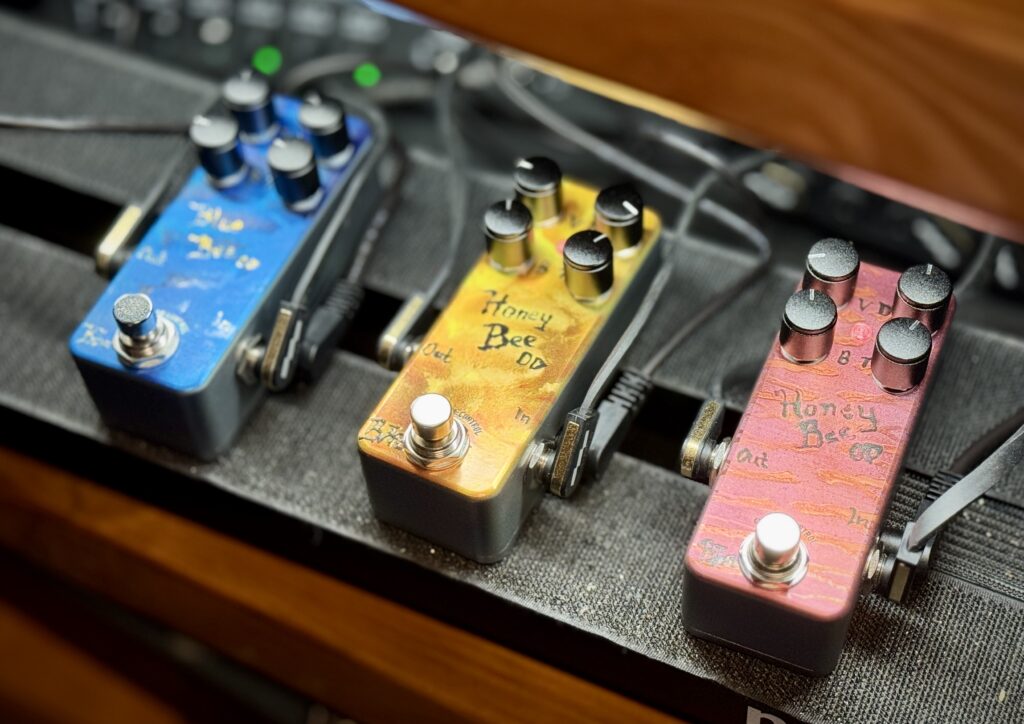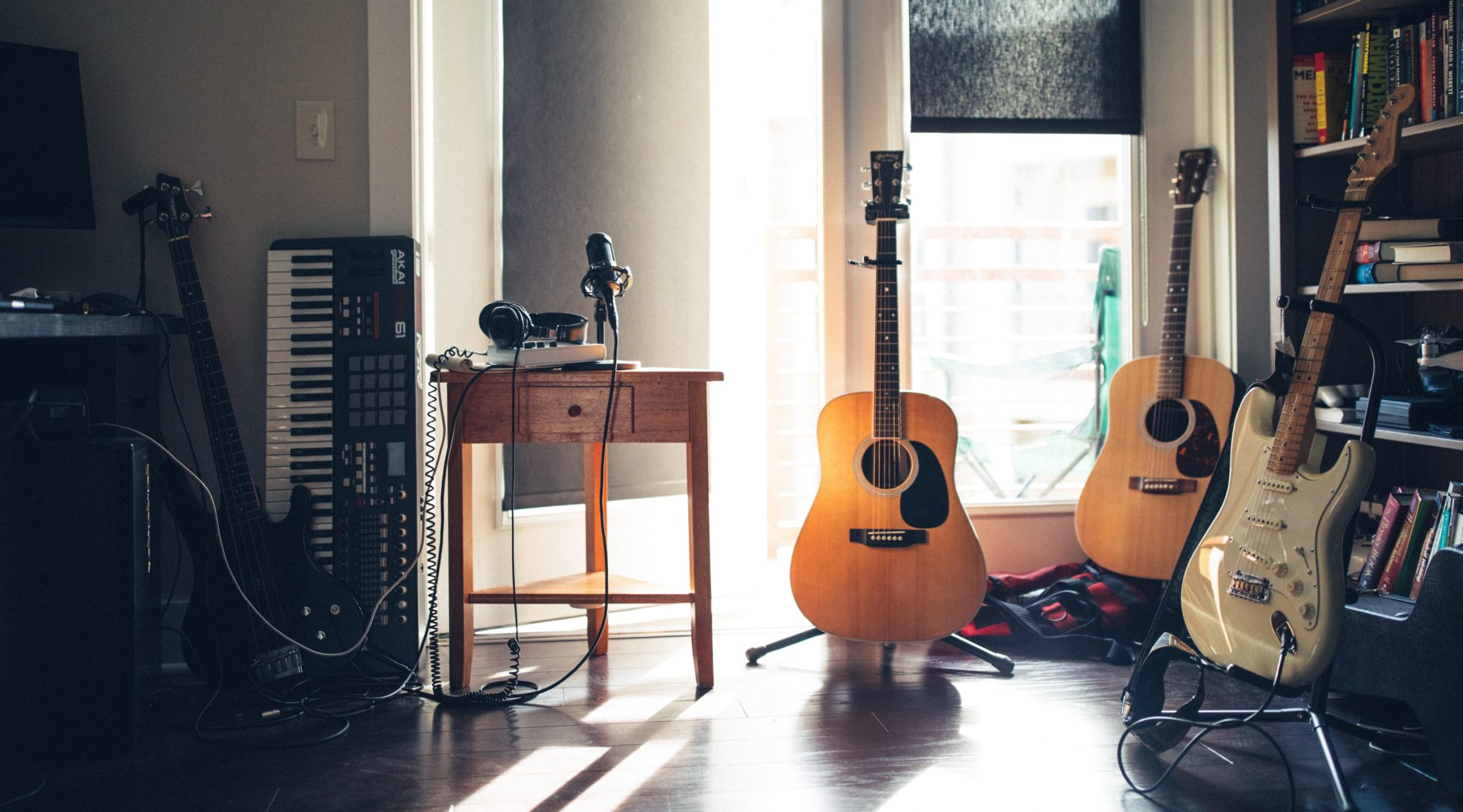I recently bought the Honey Bee OD 4K Mini Standard, from One Control.

What do I think of it? I’ve made my photo of it the wallpaper on my phone …
What Did You Buy?
I bought a One Control Honey Bee OD 4K Mini Standard pedal.
- “One Control” is the manufacturer.
- “Honey Bee” is the pedal family.
- “OD” is because this is an overdrive pedal.
- “4K” is because this pedal has 4 control knobs (the classic Honey Bee pedal only has 3 control knobs).
- “Mini” is the size of the pedal enclosure.
- “Standard” is the variant. (There’s a “Custom” variant available too; the red pedal in the photo at the top of this blog post.)
The Honey Bee OD (HBOD for short) 4K Mini Standard is a modern, surface mount device (SMD) version of the legendary Honey Bee overdrive pedal. It was designed by Björn Juhl (of BJFe fame) himself. Björn is the inventor of the original Honey Bee OD pedal, and still sells hand-wired Honey Bee pedals through his own BJFe brand.
This mini pedal (along with the “Custom” variant) was released as part of the Honey Bee’s 20th anniversary. Is it a limited edition? I’ve been unable to find out. I have seen it become unavailable, and then reappear in One Control’s catalogue.
I bought mine brand new, ordered directly from One Control in Japan.
Why Did You Buy It?
The (Other) One That Almost Got Away
It’s all thanks to this YouTube demo by Brett Kingman (which doesn’t feature the Honey Bee OD 4K Mini Standard at all …).
Let’s go back a year or two …
I missed out on buying the two Honey Bee 4K mini pedals when they first came out. I knew about them, but didn’t order them at the time. I didn’t realise that they’d be a limited run, and basically I waited too long. By the time I was ready to order from Thomann, they were gone.
Ever since, I’ve been watching out for the two mini pedals on the second-hand market, along with the hand-wired Honey Bee (which I’ll talk about in its own First Impressions post). Earlier this year, I managed to find the Mini Custom, but I just haven’t seen the Mini Standard here in the UK.
I really thought I’d missed my chance.
Then, in late May, Brett posted that YouTube demo of the hand-wired Honey Bee. (The hand-wired Honey Bee is another pedal that I thought I’d never get the chance to experience.)
That got me thinking: if he’s making a demo, One Control must have made some more. Sure enough, they were available to order from One Control’s Japanese website, with worldwide delivery 😍
While I was buying the hand-wired Honey Bee, I noticed that One Control Japan also had the Honey Been OD 4K Mini Standard on the site too. I couldn’t believe my luck.
So thank you One Control for making some more, and for hiring Brett to make his demo.
Yes, But Why This Pedal?
I collect tweed-tone pedals, and (as you’ll hear further down) this one firmly belongs in the collection.
The legendary Honey Bee family of pedals is probably the oldest tweed-tone pedal line that there is. (It’s even older than my beloved Mad Professor Sweet Honey OD, a cousin of the Honey Bee.)
I’ve owned a few Honey Bee variants over the years, and they’ve all offered something different. Spoiler alert – this one is no different. That’s a good thing.
My Rig Today
Today, I’m playing:
- my Fender 52 Reissue Telecaster (aka Jessie) and my Gibson Les Paul CR8 (aka GP)
- into the Axe-FX 3 (for the tuner)
- out to my pedalboard
- back into the Axe-FX 3 (for virtual amp, cab, delay and reverb)
- out to my audio interface
- and into my DAW.
I’m using two guitars today. Jessie is all stock, and GP has been fitted with Sigil Pickups Snakebite PAF-style humbuckers.
On the pedalboard, I have my JRAD Archer Ikon and One Control HBOD 4K Mini Standard in separate loops of my trusty Gigrig G2. This way, the Archer Ikon can’t affect the sound at all when I’m not using it.
The Axe-FX 3 is running my 57 Vintage pedal platform patch, which I have just remastered for the 28.05 firmware.
All the delay and reverb that you’re hearing is from my Axe-FX 3 preset. I have done no post-processing to the audio. I will have level-matched the audio before uploading it.
How Does It Sound?
This Is A True Low-Gain Pedal
Let’s start with my Telecaster (aka Jessie). Even with the HBOD’s halfway between 12 o’clock and 3 o’clock, it’s still quite a clean-sounding pedal:
It sounds great on its own, but the (imho) real magic of Bjorn’s circuit comes when we give it a bit of a kick.
It Comes Alive With A Boosted Input
Here, I’ve added a 3 dB boost to the signal going into the HBOD. And man, what a difference that makes to play:
The extra input signal brings out the HBOD’s party trick: just how touch-sensitive it is to play. Now, it’s my picking that controls just how gritty the HBOD gets. I can pick softer for cleaner tones, or dig in when I want a bit of dirt.
This is why I love the Honey Bee and its cousin, the Sweet Honey Overdrive, so much.
That, and the tone of course. While it isn’t chasing the tone of a tweed-era amp, the end result is firmly in that ballpark. It’s got the rounded attack and low-mid foundational warmth that I think sets tweed-era tones apart from classic Marshall tones.
Does It Klon? As Long As You’re Careful
If you’re someone who doesn’t like a touch-sensitive pedal, and you want something that’s a bit more even to play, then just stick JRAD’s Archer Ikon in front of the Honey Bee OD.
The Archer Ikon is a little more compressed, and this helps even out the variance in picking while still providing a tonal shift that goes really well with the Honey Bee OD at lower settings:
I think that’s a lovely, low-gain vintage rhythm tone.
I can fatten out the mid-range even further by turning the Gain and Volume controls on the Archer Ikon up to roughly half-way between 9 o’clock and 12 o’clock. It’s a good idea to turn down the Treble control on the Archer Ikon to somewhere below 12 o’clock, otherwise the Honey Bee OD will get a bit harsh.
Here’s how the sweet spot on the Archer Ikon sounds with Jessie:
As satisfying as that is, I think there’s an even-better sweet spot for me and my tastes.
I Run This With The Gain Cranked
For the last few weeks, I’ve been running the HBOD with the Gain control up above 4 o’clock. So far, that’s been the sweet spot for me on this pedal.
To my ears, as the Gain goes up, the mids go down, so I find it important to adjust the EQ of the input signal a little bit.
That’s another reason I like pairing this with the Archer Ikon; I can turn down the Treble control on the Archer Ikon to smooth out the top-end of the gain-cranked HBOD. The extra low-end coming out of the HBOD is easily solved by adjusting the HBOD’s Bass knob.
Or, if you’re running a hybrid rig, you can do what I do and reduce the low-end that’s going into the HBOD instead.
I have lost track of the hours I’ve already spent enjoying the Honey Bee OD like this. I’m utterly smitten.
And we haven’t even got to the Les Paul yet.
Warning: Fat, Blown-Out Tweed Tone Incoming
One of the … polarising … characteristics of early tweed amps is how their tone falls apart when they overdrive too hard. When I first got my Tweed Deluxe amp, it wasn’t a sound that I enjoyed. Recently, though, I’ve been learning to enjoy it a bit.
On some pedals, I can get a similar effect by overloading the pedal with too much low-end in the input signal. It only works on pedals that either:
- don’t shelve off enough low-end before hitting the circuit’s clipping stage(s), or
- that let the player control the effect by having an EQ control that works before the clipping stage(s)
I don’t know for certain, but to my ear it does seem that the HBOD’s Bass control is pre-clipping 🥳. If I add an EQ in the Axe-FX 3 after the HBOD to reduce the low-end in the signal, I can still hear the effects of too-much low-end blowing out the HBOD’s clipping stage(s):
For a start, the HBOD has started to fuzz out, without turning into an actual fuzz pedal. That’s something that cranked tweed amps are known to do.
Can you hear how some of the notes sound doubled? It’s something that only happens on the lower notes. And it’s an artefact that some digital Tweed Deluxe models (like the ones in the Axe-FX 3) also reproduce.
That is something I could lose myself in for days.
Yes, It Can Do More Traditional Tweed Rhythm Tones With A Les Paul
Just to finish off, yes, the HBOD can do more sensible tones too. All I need to do is back off the input a bit (either by rolling back my Les Paul bridge volume or reducing the signal out of my Axe-FX 3), and reducing the low-end a bit (a simple EQ reduction around 240 Hz does the trick).
Truth be told, I think I prefer pairing the Honey Bee OD with my Telecaster for these kinds of tones, but that’s probably because I’ve spent a lot more time using this signal chain with my Telecaster.
(Is Jessie becoming my #1 guitar?!? Stay tuned …)
Final Thoughts
This pedal is the main reason why I’m so far behind on First Impressions blog posts. From the moment I put it on my board, nothing else has had a look-in.
I wasn’t expecting that.
When I ordered the pedals from Japan, I was most excited for the hand-wired Honey Bee. I thought that would be the pedal that’d end up permanently on my board. It hasn’t even made it onto my board yet (other than to make sure it worked on arrival).
It’s going to take something incredibly special to knock this pedal off my board.
Is this the pedal that will finally knock my beloved Mad Professor Sweet Honey Overdrive (SHOD) off the board? I need to hear them side-by-side before I can decide on that …
